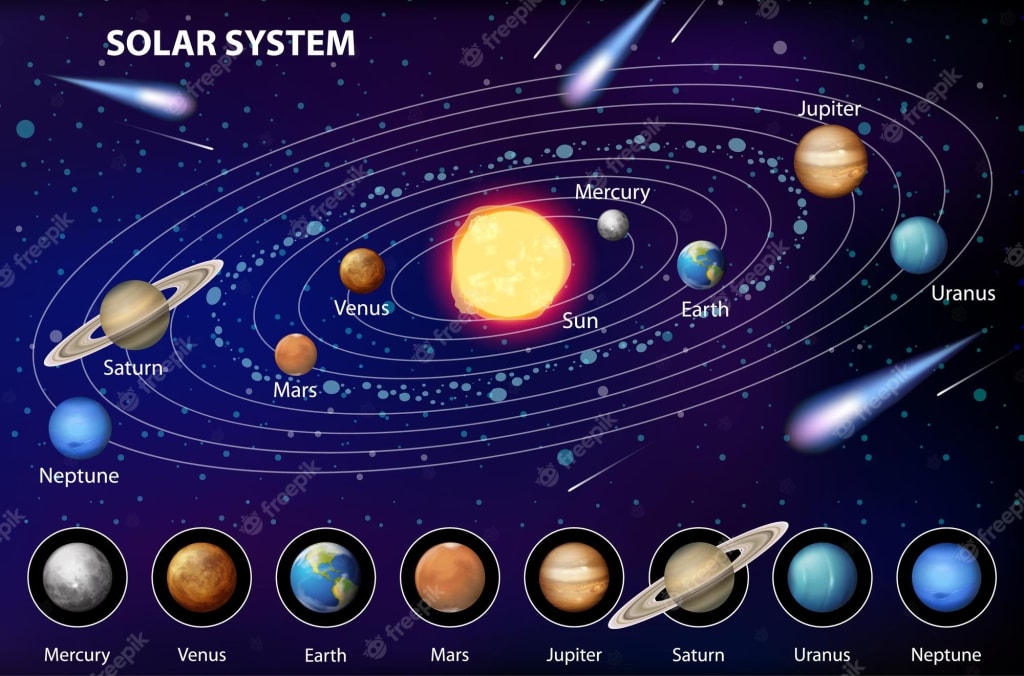
The solar system refers to the collection of celestial bodies that are gravitationally bound to the Sun. It includes not only the Sun itself but also a variety of other objects such as planets, moons, asteroids, comets, and other smaller bodies. Our solar system is just one of many similar systems that exist throughout the universe.
Here's a breakdown of some of the key components of our solar system:
Sun: The central and largest object in the solar system, primarily composed of hydrogen and helium. Its immense gravitational pull holds the entire system together and provides light and heat to the planets.
Planets: There are eight recognized planets in our solar system, categorized into two main groups:
Inner Planets (Terrestrial Planets): Mercury, Venus, Earth, and Mars. These planets are relatively small, rocky, and closer to the Sun.
Outer Planets (Gas Giants): Jupiter, Saturn, Uranus, and Neptune. These planets are larger, primarily composed of gas (primarily hydrogen and helium), and are located farther from the Sun.
Moons (Satellites): Many of the planets have natural satellites or moons orbiting around them. For example, Earth has one moon, while Jupiter has more than 70 known moons.
Asteroids and Comets: These are small, rocky or icy bodies that orbit the Sun. Asteroids are often found in the asteroid belt between Mars and Jupiter, while comets come from more distant regions and often have tails that form when they approach the Sun.
Dwarf Planets: These are smaller celestial bodies that have some planetary characteristics but do not meet all the criteria to be classified as full-fledged planets. Pluto is perhaps the most famous example of a dwarf planet.
Kuiper Belt and Oort Cloud: These are regions beyond the orbit of Neptune that are thought to contain a large number of icy bodies, including comets. The Kuiper Belt is closer to the Sun, while the Oort Cloud is much more distant and is considered the source of long-period comets.
Space Debris: There are also various types of debris in the solar system, including fragments of asteroids and comets, as well as human-made space debris from satellites and spacecraft.
Our understanding of the solar system has evolved significantly over time, thanks to advancements in astronomy and space exploration. Robotic missions, telescopes, and other tools have allowed scientists to study and explore the various components of our solar system and gain insights into its formation and evolution.
Due to their higher boiling points, only metals and silicates could exist in solid form in the warm inner Solar System close to the Sun, and these would eventually form the rocky planets of Mercury, Venus, Earth, and Mars. Because metallic elements only comprised a very small fraction of the solar nebula, the terrestrial planets could not grow very large. The giant planets (Jupiter, Saturn, Uranus, and Neptune) formed further out, beyond the frost line, the point between the orbits of Mars and Jupiter where material is cool enough for volatile icy compounds to remain solid. The ices that formed these planets were more plentiful than the metals and silicates that formed the terrestrial inner planets, allowing them to grow massive enough to capture large atmospheres of hydrogen and helium, the lightest and most abundant elements. Leftover debris that never became planets congregated in regions such as the asteroid belt, Kuiper belt, and Oort cloud.[15] The Nice model is an explanation for the creation of these regions and how the outer planets could have formed in different positions and migrated to their current orbits through various gravitational interactions
Within 50 million years, the pressure and density of hydrogen in the center of the protostar became great enough for it to begin thermonuclear fusion.






Comments
There are no comments for this story
Be the first to respond and start the conversation.